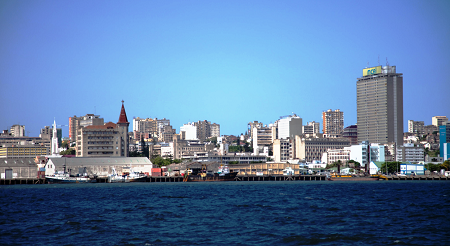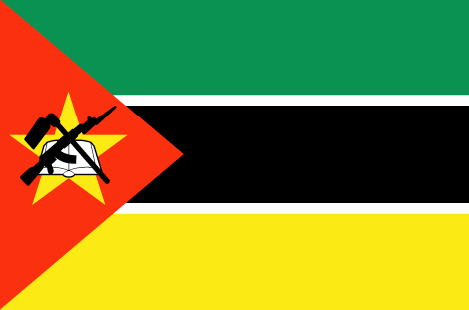


| Official name | Republic of Mozambique |
| Area | 799 380 Km2 |
| Population | 25,8 million |
| Official language | Portuguese, but many other native dialects are spoken (Makua-Lomwe, Tsonga e Sena-Nyanja) |
| Capital | Maputo |
| Administrative division | Regarding its administration, Mozambique is divided in 11 Provinces, 150 Districts, 405 Administrative Post and Localities, the lowest level of State representation. The Mozambican provinces are (by geographical order, North to South): Niassa, Cabo Delgado, Nampula, Zambézia, Tete, Manica, Sofala, Inhambane, Gaza, Maputo e Cidade de Maputo . |
| Location | Mozambique is the 34th largest country in the world in territorial area, being comparable, in size, to Trueky. It’s located in the SouthEast coast of Africa. |
| Climate | he country’s climate is humid and tropical, influenced by the Indian Ocean’s monsoon regime and by the warm streams of the Mozambique channel, with dry seasons in May and September. The average temperatures in Mozambique vary betweem 13-24ºC in July and 22-31ºC in February. The rain season takes place between October and April. |
| Time zone | Central Africal Time Zone: |
| Neighbours | Suaziland to the South; South Africa to the Southwest; Zimbabwe to the West, Zambia and Malawi to the Northwest; Tanzania to the North and the Indian Ocean to the East. |
| Geography | To the North of Zambeze river, the territory is dominated by a great plateau, with a small shore plain bordered by coral reefs and, in the interior, limited by mountainous areas belonging to the Great East African Rift Valley. To the South, it is characterized by a large coastal plain of alluvium, covered by savannas and cut by the valleys of the several rivers, like river Limpolo. |
| Mineral resources/wealth | Resources
Coal, natural gas, gold, titanium, non-metallic minerals, among others.
|
| Important cities | Maputo: 2 million |
| Demography | 25,8 million inhabitants |
| Main religion | Around half of the Mozambican population professes African traditional religions. The other represented religions are mainly Christianity (mainly Catholic) and Islam. |
| GDP | Total: 15 billion € |
| Currency | Metical (MZN) |
| Emergency telephone numbers | Fire Department: 198 |
| Constitution | Constitution of the Republic of Mozambique |
| The political system | Presidential Republic |
| President | Filipe Nyusi |
| Prime Minister | Adriano Afonso Maleiane |
| The Legislature | Republic’s Assembly with 250 seats |
| The Executive | President, Prime-Minister e Counsel of Ministers |
| The judicial branch | Supreme Court, Provincial Court, City Judicial Court |
| Foreign Policy | Participation in International Organizations: |
Road Transport:
Mozambique has one of the least developed Transport Infrastructures of Southern Africa; the road density is estimated to be of 0,05 kilometers per square kilometer. The classified road system, with 30.000 km, of which less than 20% are tarmac (5,649 km), is in good and equal condition in ca. 67% of its total lenght. However, it currently offers access to 32% of the population – those who live less than two kilometers from any road. The Road Sector is, in fact, considered as the backbone of transportation in Mozambique, in terms of physically achieving the wide unification of the country in the consolidation process of an area of ca. 800,000 square kilometers, in terms of socio-economic development, in terms of developing the economic attraction for the country’s transit routes, and, recently, for the touristic development.
Detailed Road Map of Mozambique
Distance between cities:
Maputo – Nampula (2000 km)
Maputo – Inhambane (470 km)
Maputo – Manica (1200 km)
Railroad transport
The railroad network amounts to a total of 3,123 km, with extensive connections currently being renovated.
Air Transport
The country has 22 airports, among which 4 have landing strips with over 2.438 km in length.
Mozambique is an African country, that has borders with Tanzania, Malawi, Zambia, Zimbabwe, South Africa and Eswatini, with an extensive coast of 2500 kilometers over Indian Ocean (WorldBank, 2020). It is a country where most of the population, works in rural areas (WorldBank, 2020) and it was a big quantity of arable land, energy, water, minerals resources, natural gas, with 3 seafarers ports in deep waters and also with a reserve of high labor (WorldBank, 2020). Also, Mozambique as great ties with South Africa, that is the economic engine of the region, what underlines the “importance of its economic, political and social development for the stability and growth of Southern Africa as a whole” (WorldBank, 2020). Mozambique largest partners are South Africa and Portugal, and also countries like Brazil, China, Japan and India are establishing projects in the country and increasing their investments (Anon., 2019). The United States is the biggest bilateral donor of development assistance, becoming a big trade partner, due to its investment in the oil and gas sector (Anon., 2019).
It is important to mention that Mozambique has an economic structure that is characterized by the asymmetric differences between the North, less developed, with the South, more developed, of the country, and also between the countryside and the city, that are related with an absence of economic integrity and the extreme oppression of the labor (Anon., s.d). The government decided to develop a strategy of the development to combat these asymmetric differences, with a centrally planned socialist economy, however, it wasn’t possible due to the international and regional conjectures, natural disasters and also due to military conflict (Anon., s.d).
Since 1987, the country has been registering an economic growth, with the increasing of GDP every year on 7% or 8%, with the inflation below the 10%, and also with the fact the Mozambique has the Africa’s most liberalized currency movements (Anon., 2020). However, in 2016, the growth of Mozambique was interrupted due to the high volumes of extern debt that wasn’t declared, that promoted distrust in the country, increase the debt levels and reduced the growth rate (Worldbank, 2020). Also, in 2019, there were two natural disasters, the ‘Idai’ and ‘Kenneth’ cyclones, that also contributed to reduced that growth of the country and the well-being of the population, because it affected the infrastructures, and the subsistence means (WorldBank).
In 2020, the Covid-19 pandemic also affected Mozambique, what increased the difficulties from 2016 and from 2019, retreating the economic perspectives of the country. There is a reduction of offer and demand in raw material, that are mitigating the investment in gas and in coal (WorldBank, 2020). There was a perspective of the fall of growth in 1,3% in 2020 (WorldBank, 2020).
However, it is expected by the FocusEconomics, a grow of the GDP in 2.8% in 2021 and 5.5% in 2022 (FocusEconomics, 2020).
Doing Business in Mozambique
Although Mozambique is passing by the Covid-19 pandemic, like most of the countries in the world, there are still reasons to invest in Mozambique.
First, due to its strategic localization, related to its borders, where four of the six countries are interiors, what means that they are dependent from Mozambique to get access to global markets (WorldBank, 2020), which can be very beneficial for the foreign investors, because Mozambique can be the entry to get to the interior countries market.
Second, the liquefied natural gas reserves, where Mozambique is the third largest holder in Africa (Anon., 2021), that is a good area for the foreign investors to invest.
Third, besides natural gas the country has a big variety of other natural resources, in energy, mines, forestry, agriculture and fishing, which mean that foreign investors have a lot of different types of resources where they can invest (Anon., 2021).
Forth, Mozambique is one of the fastest growing economies (Editor, 2021), with an economic growth of 7% and 8% per year (Anon., 2020), which means that the foreign investors can grow alongside with the Mozambique economy.
Fifth, has young population and an expanding labor force, with 45% of the Mozambican population, in 2016 was 15 and below, that can contribute in the future to the labor force, with a growing population, that means a growing consumer market besides de labor force (Anon., s.d).
Sixth, this young population and labor force can be hired by a low price, depending on the sector, which means that foreign investors can hire people without spending to much money (Anon., s.d).
Seventh, Mozambique has as high priority becoming more sustainable, and for that they can use foreign investors, because they have different perspectives, different innovative approves and experience that can contribute to the development of the sustainability of the country (Anon. s.d).
Eight, Mozambique needs to amplify its current demand in water, electricity, housing, waste management, infrastructure, agriculture and healthcare, because they are insufficient to the needs of its population, which means that it can be an opportunity to the foreign investors (Anon., s.d).
After understanding the reasons to invest in Mozambique, it is also important to know which sectors are the most profitable ones for the foreign investors to invest. The most important sectors to invest in Mozambique are infrastructure, due to its weakness in this sector; with the hydroelectric and thermal power generation, due it’s strong potential; and in transportation, because it is a sector that is expanding (Anon., s.d, 2019).
The tourism in Mozambique is gradually achieving its great potential in the national economic, consequence of the investment throughout previous years. The country has been investing in tourism, especially tourism focused on the country’s biodiversity and nature conservation projects and for a sustainable economic growth. The Mozambican Government has been attributing growing importance to this activity, since it’s a relevant sector for the country’s economic development, due to its ability to create jobs, promoting infrastructure construction, push forth the development of local economies and generate foreign exchange. It’s worth noting that the tourism’s contribution for the GDP is just 2.1% (2011 data). The geographical location and the country’s natural beauty place it in a privileged and competitive situation in the African touristic market. However, the complete development of this sector faces some hindrances, namely deficiencies at the level of transport, sanitation and water supply infrastructures, in addition to high travel prices, making Mozambique not accessible enough to European and Western markets.
Regarding the hotel business, Mozambique has been having a considerable growth, particularly in luxury and first class hotels. According to data from the World Tourism Organization (UNWTO), Mozambique has 1.435 hotels and similar establishments. According to the UNWTO, in 2013 Mozambique welcomed ca. 2 million tourists, which represents a y-y decrease of 10.7%.
Regarding the revenues generated by the touristic activity, data from 2013 show a decrease of 3.6% in comparison to the previous year, in a total of 241 million USD. Around 72% of tourists visiting Mozambique come from the African continent (South Africa with 44.4% of the total and Malawi with 12% as the main origins of African tourists). Europe represents 20% of the total of tourists, with Portugal and the UK as the main origins (3.9% and 2.6%, respectively).
AICEP Portugal Global